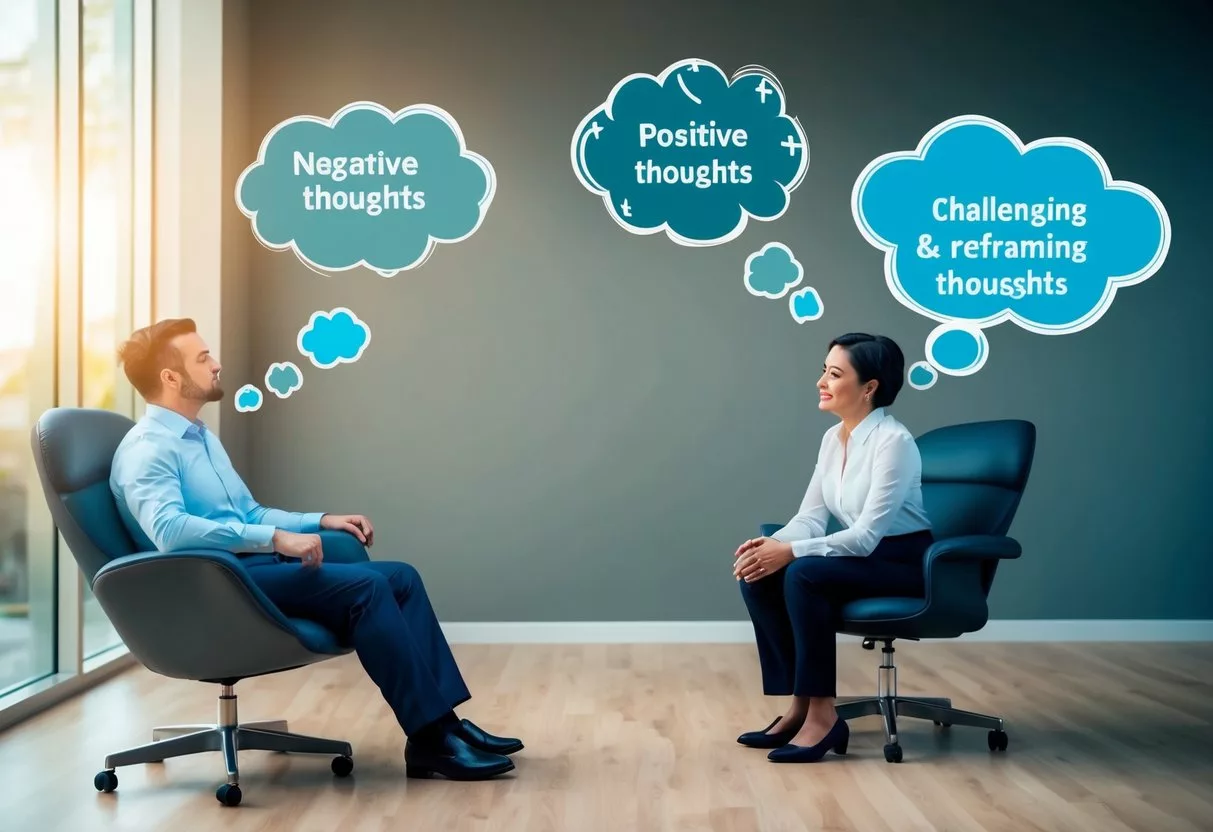Cognitive Behavioral Therapy (CBT) is a type of talk therapy that helps people change negative thoughts and behaviors.
CBT can treat many mental health issues, including depression, anxiety, and PTSD.
This therapy focuses on the connection between thoughts, feelings, and actions.

CBT works by teaching people to spot and challenge unhelpful thinking patterns. A therapist guides patients to examine their thoughts and replace them with more balanced ones. This process can lead to better emotional control and healthier behaviors.
During CBT sessions, people learn practical skills to cope with life’s challenges.
These skills can include relaxation techniques, problem-solving methods, and ways to face fears.
CBT is often short-term, with results seen in a few months of weekly sessions.
Understanding Cognitive Behavioral Therapy (CBT)
Cognitive Behavioral Therapy (CBT) is a widely used form of psychological treatment. It helps people change negative thought patterns and behaviors to improve their mental health and well-being.
Foundational Principles
CBT is based on the idea that thoughts, feelings, and behaviors are connected. It focuses on identifying and changing harmful thinking and behavior patterns. The main goal is to help people develop more balanced and helpful ways of thinking.
CBT was developed by Aaron Beck in the 1960s. He noticed that his patients often had negative thoughts that affected their emotions and actions.
Key principles of CBT include:
• Recognizing unhelpful thoughts
• Challenging negative beliefs
• Learning new coping skills
• Practicing these skills in real-life situations
Comparison with Other Therapy Forms
CBT differs from other types of therapy in several ways:
- It’s more structured and goal-oriented.
- It focuses on the present rather than past experiences.
- It teaches specific skills that clients can use on their own.
Unlike some other therapies, CBT doesn’t dwell on childhood experiences or unconscious motivations. Instead, it deals with current problems and how to solve them.
CBT sessions are usually shorter and more frequent than traditional psychotherapy. A typical course of CBT might last 12-20 weeks, with weekly sessions.
CBT Modalities
CBT can be delivered in various ways to suit different needs and preferences:
• Individual therapy: One-on-one sessions with a therapist
• Group therapy: Sessions with a small group of people facing similar issues
• Online CBT: Therapy delivered through digital platforms or apps
• Self-help books: Guided CBT exercises for people to work through on their own
Cognitive Behavioral Therapy can be used to treat many mental health conditions. These include depression, anxiety disorders, eating disorders, and substance abuse problems.
CBT techniques can be combined with other treatments like medication. This approach often leads to better outcomes for many people.
The Process of CBT

Cognitive behavioral therapy follows a structured approach to help people change unhelpful thoughts and behaviors. It involves several key components that work together to create lasting positive change.
Assessment and Goal Setting
The CBT process starts with a thorough assessment. A therapist meets with the client to discuss their concerns and history. They work together to identify specific problems to address.
The therapist and client set clear, measurable goals for therapy. These goals focus on reducing symptoms and improving daily functioning.
Common goals include:
• Reducing anxiety or depression symptoms
• Changing negative thought patterns
• Improving relationships or communication skills
Goals are broken down into smaller, achievable steps. This creates a roadmap for therapy sessions.
Structuring the Therapy Sessions
CBT uses a structured approach for each therapy session. A typical session lasts 45-60 minutes and follows a set format:
- Review of the past week and any homework
- Setting an agenda for the current session
- Working on specific skills or techniques
- Assigning new homework
The therapist takes an active role in guiding sessions. They teach clients to recognize unhelpful thoughts and behaviors.
Clients learn skills to challenge and change these patterns.
Sessions often involve role-playing, problem-solving exercises, and practicing new coping strategies. The therapist provides feedback and support throughout.
Homework Assignments
Homework is a key part of CBT. It allows clients to practice new skills between sessions.
Common homework tasks include:
• Keeping thought records to track negative thinking patterns
• Trying out new behaviors in real-life situations
• Practicing relaxation or mindfulness exercises
The therapist and client review homework at the start of each session. They discuss any challenges and celebrate successes.
Homework helps reinforce what is learned in therapy.
Completing homework increases the chances of long-term success. It helps clients apply CBT skills to their daily lives.
Applications of CBT
Cognitive Behavioral Therapy (CBT) is used to treat many mental health issues. It helps people change negative thought patterns and behaviors. CBT can be effective for various conditions, from mood disorders to addiction.
Depression and Anxiety
CBT is very helpful for treating depression and anxiety disorders. If you want more information about CBT and anxiety here is a great resource for you to read: Understanding CBT for Anxiety: An Evidence-Based Approach to Mental Wellness.
For depression, it teaches people to spot and change negative thoughts. This can improve mood and boost motivation.
With anxiety, CBT helps patients face fears step by step. It also teaches relaxation methods.
People learn to question worried thoughts and try new behaviors.
CBT often includes homework. Patients might keep thought logs or try new actions between sessions.
This helps them practice skills in real life.
Results can happen in just a few months of CBT. Many find it works as well as or better than medicine for these issues.
Eating Disorders and OCD
CBT is a key treatment for eating disorders and OCD.
With eating disorders, it tackles distorted body image and food beliefs. Patients learn healthy eating habits and ways to cope with triggers.
For OCD, CBT uses exposure and response prevention. This means facing fears without compulsions. Over time, anxiety levels drop.
CBT helps people spot OCD thoughts and resist rituals. They learn that anxiety will pass without compulsions.
This can greatly reduce OCD symptoms.
Both conditions benefit from CBT’s focus on changing thoughts and behaviors. Patients gain tools to manage their conditions long-term.
Addiction and Substance Use Disorders
CBT is effective for treating addiction and substance use issues.
It helps people spot triggers that lead to drug or alcohol use. Then, it teaches healthier ways to cope.
Patients learn to question thoughts that drive substance use. They practice saying no and handling cravings.
CBT also addresses underlying issues like stress or low self-esteem.
Role-playing is often used to practice new skills. Patients might act out risky situations and plan how to stay sober. They also learn to build a support network and find new hobbies.
CBT can be done one-on-one or in groups. It often works well with other treatments like medication.
Other Mental Health Conditions
CBT helps with many other mental health issues.
It’s useful for PTSD, teaching ways to process trauma and reduce flashbacks. For bipolar disorder, CBT helps manage mood swings and stick to treatment plans.
With schizophrenia, CBT can reduce symptoms and improve social skills. It also helps people cope with hallucinations. For personality disorders, CBT teaches healthier ways to think and interact.
Even physical health issues benefit from CBT.
It can help manage chronic pain, sleep problems, and stress. CBT teaches people to change negative thoughts about their conditions.
The skills learned in CBT are useful for many life challenges. They help people become their own therapists over time.
CBT Techniques and Strategies

Cognitive behavioral therapy uses specific methods to help people change unhelpful thoughts and behaviors. These techniques target both mental processes and actions.
Cognitive Techniques
Cognitive techniques focus on identifying and changing negative thought patterns. One key method is cognitive restructuring, which involves recognizing distorted thoughts and replacing them with more balanced ones.
Therapists may use thought records to help clients track their thoughts and emotions. This allows people to spot recurring negative patterns.
Another technique is guided discovery. The therapist asks questions to help clients examine their beliefs from different angles. This can lead to new perspectives on situations.
Mindfulness practices are also used to increase awareness of thoughts without judgment. This helps create distance from unhelpful thinking.
Behavioral Techniques
Behavioral techniques aim to change problematic actions and habits.
One common method is behavioral activation, which involves scheduling positive activities to improve mood and energy.
Therapists may use role-playing to practice new social skills or coping methods. This allows clients to rehearse difficult situations in a safe environment.
Relaxation training teaches ways to reduce physical tension. Deep breathing, progressive muscle relaxation, and guided imagery are often used.
Another key technique is problem-solving training. This helps clients break down complex issues into manageable steps and find solutions.
Exposure Therapy
Exposure therapy is used to treat anxiety disorders and phobias. It involves gradual, controlled exposure to feared situations or objects.
The process starts with creating a fear hierarchy. This ranks fears from least to most distressing.
Clients then face each item on the list, starting with the least feared. They stay in the situation until anxiety decreases.
Virtual reality is sometimes used for exposure therapy. This allows people to confront fears in a simulated environment.
Exposure can be done in real life (in vivo) or through imagination (imaginal exposure). The method depends on the specific fear and client preferences.
The Role of Therapists

Therapists play a crucial part in cognitive behavioral therapy. They guide patients through the process, helping them identify and change unhelpful thoughts and behaviors.
Qualifications and Approaches
Therapists who practice cognitive behavioral therapy (CBT) come from various backgrounds. They may be psychologists, psychiatrists, or counselors. Most have a master’s degree or higher in mental health fields.
These professionals use different approaches within CBT. Some focus on cognitive techniques, while others emphasize behavioral strategies. Many combine both methods.
Therapists often tailor their approach to each patient’s needs. They may use worksheets, role-playing, or homework assignments to help patients practice new skills.
Therapist-Patient Relationship
The relationship between therapist and patient is key in CBT. Therapists aim to create a safe, trusting environment where patients feel comfortable sharing their thoughts and feelings.
In CBT, therapists take an active role. They ask questions, offer feedback, teach coping skills, and challenge unhelpful thoughts.
Patients are expected to be active participants too. They work with their therapist to set goals and practice new behaviors between sessions.
Specializations and Training
Many therapists specialize in treating specific issues with CBT. For example, some focus on anxiety disorders, depression, eating disorders, or substance abuse.
Ongoing training is important for CBT therapists. They often attend workshops and conferences to learn new techniques and stay up-to-date with research.
Some therapists pursue additional certifications in CBT. These show their expertise and commitment to the approach.
Therapists may also specialize in certain age groups, like children or older adults. This allows them to tailor CBT techniques to different developmental stages.
CBT and Co-occurring Disorders

Cognitive Behavioral Therapy (CBT) helps people with multiple mental health issues at the same time. It works well for different problems that often happen together.
Chronic Pain and Illness
CBT helps people cope with long-term pain and sickness. It teaches ways to deal with pain that don’t involve drugs. People learn to change how they think about their pain, which can make the pain feel less bad.
CBT also helps with the stress of being sick for a long time. It gives people tools to handle hard feelings. They learn to spot thoughts that make them feel worse, then they can swap those thoughts for more helpful ones.
Studies show CBT can lower pain levels. It also helps people do more daily tasks. Many find they need less medicine when they use CBT skills.
Trauma and PTSD
CBT is very good for treating trauma and PTSD. It helps people face memories that scare them and learn that these memories can’t hurt them now.
CBT teaches ways to relax when feeling stressed. People practice new responses to things that remind them of the trauma. This helps them feel more in control.
For PTSD with drug problems, CBT works on both issues. It helps people understand how trauma and drug use are linked. They learn better ways to cope than using drugs.
Severe Mental Illness
CBT can help people with very serious mental health problems, like schizophrenia. It teaches them to question odd thoughts they might have and learn to tell the difference between what’s real and what’s not.
People also learn to practice social skills and ways to solve problems. This helps them cope better in daily life.
CBT also works well with medicine for severe mental illness. It helps people stick to their treatment plan and learn to spot early signs of getting worse.
Measuring CBT Effectiveness

Cognitive Behavioral Therapy (CBT) has shown promising results in treating various mental health conditions. Research has examined its impact on patient outcomes and quality of life.
Success Rates and Clinical Evidence
Clinical measures guide CBT and help monitor patient progress. These tools provide insight into symptoms and functioning. Studies have found CBT effective for many conditions.
CBT often outperforms other therapies and medication alone. Success rates vary by condition, but many patients show significant improvement.
Research suggests CBT helps build resilience and stress management skills. These benefits can extend beyond the initial treatment period.
Quality of Life and Long-term Outcomes
CBT aims to improve overall well-being, not just reduce symptoms. Studies have examined its impact on quality of life measures, such as social functioning, work performance, relationships, and self-esteem.
Many patients report lasting benefits after completing CBT. They often gain tools to manage future challenges.
Follow-up studies show maintained improvements months or years after treatment. This suggests CBT provides durable skills for long-term mental health.
CBT’s focus on practical skills may contribute to its lasting effects. Patients learn to identify and change unhelpful thought patterns.
Challenges in CBT

Cognitive Behavioral Therapy faces several obstacles in practice. These include patient resistance, critiques of the approach, and difficulties adapting it for diverse groups.
Resistance to Therapy
Some patients struggle to engage fully in CBT. They may have trouble recognizing learned patterns of unhelpful behavior. Deeply ingrained beliefs can be hard to change.
Patients might resist homework assignments or practicing new coping skills. They may also feel uncomfortable discussing painful thoughts and emotions.
Therapists need strategies to overcome this resistance. Building trust and explaining the CBT process clearly can help. Tailoring the approach to each patient’s needs is key.
Limitations and Criticisms
Critics argue CBT focuses too much on present issues and may not address deeper, underlying problems. Some feel it oversimplifies complex mental health conditions.
CBT’s structured nature can feel rigid to some patients, and it may not suit those who prefer a more open-ended approach. Research also shows CBT is not equally effective for all conditions, and its long-term benefits are debated for some disorders.
Adapting CBT for Diverse Populations
CBT was developed mainly in Western cultures, so adapting it for different cultural backgrounds can be challenging.
Language barriers may affect therapy effectiveness, and cultural beliefs about mental health can impact how CBT is received.
Therapists need cultural competence training. They must also adjust CBT techniques to fit diverse values and worldviews.
Modifying CBT for different age groups, like children or older adults, requires special skills. Therapists must adapt their communication style and methods.
Integration with Other Therapeutic Approaches

Cognitive Behavioral Therapy (CBT) can be combined with other therapeutic approaches to enhance its effectiveness. These integrations blend CBT techniques with complementary methods to address complex mental health issues.
Dialectical Behavior Therapy (DBT)
DBT combines CBT with mindfulness practices. It was developed to treat borderline personality disorder but is now used for other conditions. DBT focuses on four key skills: mindfulness, distress tolerance, emotion regulation, and interpersonal effectiveness.
DBT helps patients accept their emotions while learning to change harmful behaviors. It uses individual therapy, group skills training, and phone coaching.
Therapists teach coping strategies for intense emotions and difficult situations. Patients learn to balance acceptance and change in their lives.
Rational Emotive Behavior Therapy (REBT)
REBT is a form of CBT that focuses on identifying and changing irrational beliefs. It was developed by Albert Ellis in the 1950s.
Key principles of REBT include challenging negative thought patterns, developing more rational and flexible thinking, and taking responsibility for one’s emotions and behaviors.
REBT uses the ABC model, which stands for activating event, beliefs about the event, and consequences (emotional and behavioral). Therapists help patients dispute irrational beliefs and replace them with more helpful ones. This leads to healthier emotional responses and behaviors.
Mindfulness-Based Cognitive Therapy
This approach combines CBT techniques with mindfulness practices. It was originally developed to prevent relapse in depression.
MBCT teaches patients to observe their thoughts without judgment, recognize early signs of depressive relapse, and respond to negative thoughts more effectively.
The therapy includes guided meditations, yoga, and body awareness exercises. Patients learn to step back from their thoughts and see them as mental events, not facts.
MBCT helps break the cycle of negative thinking that can lead to depression. It’s also used for anxiety, chronic pain, and other conditions.
CBT in Different Settings
Cognitive Behavioral Therapy (CBT) can be done in many ways. People can get CBT alone or in groups, and they can do it online or in person. CBT also happens in places like schools and prisons.
Individual vs. Group Therapy
CBT works well for one person or many people at once. In individual therapy, a person meets with a therapist alone, and they can focus on their own issues. The therapist gives them full attention.
Group therapy brings people with similar problems together. They learn from each other’s experiences, and it can be cheaper than one-on-one therapy. Some people feel less alone in a group.
Both types can help people change how they think and act. The best choice depends on what a person needs and likes.
Teletherapy and Face-to-Face Therapy
Face-to-face CBT happens in a therapist’s office, where people meet their therapist in person. This lets them build a close bond, and the therapist can see body language and facial expressions.
Teletherapy happens online or by phone. It’s good for people who can’t leave home easily, and some find it more comfortable than in-person meetings.
Both ways can work well, and studies show teletherapy can be just as good as face-to-face for many issues. Health insurance often covers both types now.
CBT in Institutional Settings
CBT is used in many places besides therapy offices. Schools use it to help students with anxiety or behavior problems, and prisons use CBT to help inmates change harmful thoughts and actions.
Hospitals use CBT for patients with mental health issues, and it can help people cope with physical illnesses too.
In these settings, CBT is often part of a bigger treatment plan, and it might be mixed with other therapies or programs. The goal is to help people in these places learn better ways to think and act.
Frequently Asked Questions
Cognitive behavioral therapy uses specific techniques to treat mental health issues. It focuses on changing thoughts and behaviors through structured sessions and exercises.
What techniques are commonly used in cognitive behavioral therapy?
Cognitive behavioral therapy (CBT) uses several key techniques. These include identifying negative thought patterns and replacing them with more realistic ones, and therapists may also use role-playing to practice new behaviors. Exposure therapy is another common CBT technique for treating phobias and anxiety.
How can cognitive behavioral therapy be applied to treat anxiety?
CBT can help people with anxiety by teaching them to recognize and change anxious thoughts. Patients learn to challenge irrational fears and face anxiety-provoking situations gradually, and relaxation techniques like deep breathing are often incorporated. CBT also helps develop coping strategies to manage anxiety symptoms.
What are the core components of cognitive behavioral therapy?
The main components of CBT are cognitive restructuring and behavioral activation. Cognitive restructuring involves identifying and changing negative thought patterns, while behavioral activation focuses on increasing positive activities and behaviors. CBT also emphasizes problem-solving skills and setting achievable goals.
What is involved in a typical cognitive behavioral therapy session?
A typical CBT session lasts about 50 minutes. The therapist and patient review progress on homework from the previous session, and they discuss current issues and practice CBT techniques. The session ends with assigning new homework to reinforce skills learned.
How can I find a qualified cognitive behavioral therapist near me?
To find a CBT therapist, start by asking your doctor for a referral. You can also search online directories of licensed therapists who specialize in CBT, and make sure to verify the therapist’s credentials and experience. Many now offer virtual sessions in addition to in-person appointments.
What are some exercises that can be practiced in cognitive behavioral therapy?
Common CBT exercises include thought records to track negative thoughts. Patients may practice reframing these thoughts more positively.
Another useful exercise is scheduling pleasant activities. Relaxation techniques like progressive muscle relaxation are often taught as well.